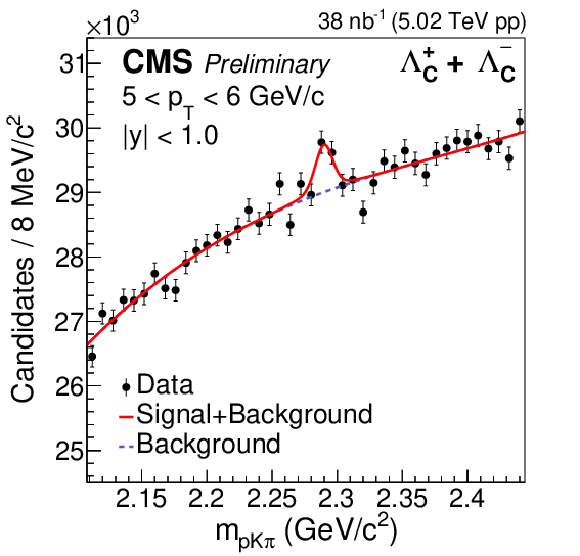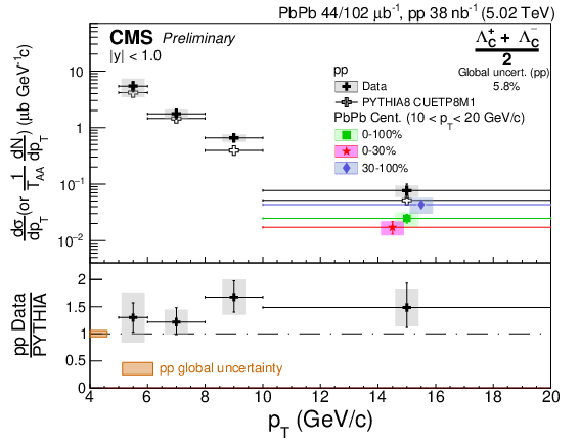

Compact Muon Solenoid
LHC, CERN
| CMS-PAS-HIN-18-009 | ||
| Production of Λ+C baryons in proton-proton and lead-lead collisions at √sNN= 5.02 TeV | ||
| CMS Collaboration | ||
| May 2019 | ||
| Abstract: The differential cross sections of Λ+C baryon production are measured via the exclusive decay channel Λ+C→pK−π+, as a function of transverse momentum (pT) in proton-proton (pp) and lead-lead (PbPb) collisions at a nucleon-nucleon center-of-mass energy of 5.02 TeV with the CMS detector at the LHC. The measurement is performed within the Λ+C rapidity interval |y|< 1.0 in the pT range of 5-20 GeV/c in pp and 10-20 GeV/c in PbPb collisions. The observed yields of Λ+C for pT of 10-20 GeV/c suggest a possible suppression in central PbPb collisions compared to pp collisions. The Λ+C/D0 production ratio in pp collisions is compared to theoretical models. In PbPb collisions, this ratio is consistent with the result from pp collisions in their common pT range. | ||
|
Links:
CDS record (PDF) ;
CADI line (restricted) ;
These preliminary results are superseded in this paper, PLB 803 (2020) 135328. The superseded preliminary plots can be found here. |
||
| Figures | |

png pdf |
Figure 1:
Invariant mass distribution of Λ+C candidates with pT= 5-6 GeV/c (left), 10-20 GeV/c (middle) in pp collisions, and pT= 10-20 GeV/c in PbPb collisions within the centrality range 0-100% (right). The solid line represents the full fit and the dashed line represents the background component. |

png pdf |
Figure 1-a:
Invariant mass distribution of Λ+C candidates with pT= 5-6 GeV/c in pp collisions. The solid line represents the full fit and the dashed line represents the background component. |

png pdf |
Figure 1-b:
Invariant mass distribution of Λ+C candidates with pT= 10-20 GeV/c in pp collisions. The solid line represents the full fit and the dashed line represents the background component. |

png pdf |
Figure 1-c:
Invariant mass distribution of Λ+C candidates with pT= 10-20 GeV/c in PbPb collisions within the centrality range 0-100%. The solid line represents the full fit and the dashed line represents the background component. |

png pdf |
Figure 2:
The pT-differential cross sections for Λ+C baryon in pp collisions and in three centrality regions of PbPb collisions, along with the PYTHIA8 calculation for pp collisions. The boxes and error bars represent the systematic and statistical uncertainties, respectively. The PbPb data points are shifted in the horizontal axis for clarity. The lower panel shows the ratio of the measured pT-differential cross section in pp data to the PYTHIA8 calculation. The box at unity in the lower panel indicates the 5.8% normalization uncertainty for pp collision arising from the integrated luminosity and branching fraction. The PbPb normalization uncertainty is included in the systematic uncertainty for each point. |

png pdf |
Figure 3:
The nuclear modification factor RAA versus <Npart>. The boxes and error bars on the data points represent the systematic and statistical uncertainties in the numerator of Eq. (1), respectively. The box at unity indicates the total uncertainty in the pp differential cross section, which is common to all three RAA values. |

png pdf |
Figure 4:
The Λ+C/D0 production cross section ratio versus pT from pp collisions as well as 0-100% centrality PbPb collisions. The boxes and error bars represent the systematic and statistical uncertainties, respectively. The PbPb data point is shifted in the horizontal axis for clarity. The open crosses and open stars represent the predictions of PYTHIA8 with the CUETP8M1 tune and with color reconnection [34], respectively. The black and pink lines are the calculations from Ref. [29] and Ref. [35], respectively. All predictions are for pp collisions. |
| Tables | |

png pdf |
Table 1:
Summary of the <Ncoll>, <TAA>, and <Npart> values for three PbPb centrality ranges. |
| Summary |
| The pT-differential cross sections of Λ+C baryons have been measured in pp and PbPb collisions at a nucleon-nucleon center-of-mass energy of 5.02 TeV. The shape of the pT distribution in pp collisions is well described by the PYTHIA8 event generator. A hint of suppression of Λ+C production for 10 <pT< 20 GeV/c is observed in PbPb when compared to pp data, with central PbPb events showing stronger suppression. This possible suppression may originate from the strong interaction between the charm quark and the quark-gluon plasma medium, as previously indicated by the D0 meson measurements. The Λ+C/D0 production ratios in pp collisions are consistent with a model obtained by adding color reconnection in hadronization to PYTHIA8, and also with a model that includes enhanced contributions from the decay of excited charm baryons. A model including coalescence underpredicts the data for pT above about 8-10 GeV/c. The Λ+C/D0 production ratios in pp and PbPb collisions for pT= 10-20 GeV/c are found to be consistent with each other. These two observations may suggest that the coalescence process does not play a significant role in Λ+C baryon production in this pT range. |
| References | ||||
| 1 | E. V. Shuryak | Theory of Hadronic Plasma | Sov. Phys. JETP 47 (1978) 212.[Zh. Eksp. Teor. Fiz. 74 (1978) 408] | |
| 2 | A. Beraudo et al. | Extraction of Heavy-Flavor Transport Coefficients in QCD matter | NP A 979 (2018) 21 | 1803.03824 |
| 3 | V. Greco, C. M. Ko, and P. L\'evai | Parton Coalescence and the Antiproton/Pion Anomaly at RHIC | PRL 90 (2003) 202302 | nucl-th/0301093 |
| 4 | STAR Collaboration | Identified baryon and meson distributions at large transverse momenta from Au+Au collisions at √sNN= 200 GeV | PRL 97 (2006) 152301 | nucl-ex/0606003 |
| 5 | STAR Collaboration | Systematic Measurements of Identified Particle Spectra in pp, d+Au and Au+Au Collisions from STAR | PRC 79 (2009) 034909 | 0808.2041 |
| 6 | STAR Collaboration | Observation of D0 meson nuclear modifications in Au+Au collisions at √sNN= 200 GeV | PRL 113 (2014) 142301 | 1404.6185 |
| 7 | Y. Oh, C. M. Ko, S. H. Lee, and S. Yasui | Heavy baryon/meson ratios in relativistic heavy ion collisions | PRC 79 (2009) 044905 | 0901.1382 |
| 8 | S. H. Lee et al. | Λc enhancement from strongly coupled quark-gluon plasma | PRL 100 (2008) 222301 | 0709.3637 |
| 9 | S. Ghosh et al. | Diffusion of Λc in hot hadronic medium and its impact on Λc/D ratio | PRD 90 (2014) 054018 | 1407.5069 |
| 10 | ALICE Collaboration | Λ+c production in pp collisions at √s= 7 TeV and in p-Pb collisions at √sNN= 5.02 TeV | JHEP 04 (2018) 108 | 1712.09581 |
| 11 | ALICE Collaboration | Λ+c production in Pb-Pb collisions at √sNN= 5.02 TeV | Submitted to: PLB (2018) | 1809.10922 |
| 12 | LHCb Collaboration | Prompt charm production in pp collisions at √s= 7 TeV | NPB 871 (2013) 1 | 1302.2864 |
| 13 | LHCb Collaboration | Prompt Λ+c production in pPb collisions at √sNN= 5.02 TeV | JHEP 02 (2019) 102 | 1809.01404 |
| 14 | M. A. G. Aivazis, J. C. Collins, F. I. Olness, and W.-K. Tung | Leptoproduction of heavy quarks. II. A unified QCD formulation of charged and neutral current processes from fixed-target to collider energies | PRD 50 (1994) 3102 | |
| 15 | CMS Collaboration | Nuclear modification factor of D0 mesons in PbPb collisions at √sNN= 5.02 TeV | PLB 782 (2018) 474 | CMS-HIN-16-001 1708.04962 |
| 16 | CMS Collaboration | The CMS experiment at the CERN LHC | JINST 3 (2008) S08004 | CMS-00-001 |
| 17 | CMS Collaboration | Observation and studies of jet quenching in PbPb collisions at nucleon-nucleon center-of-mass energy = 2.76 TeV | PRC84 (2011) 024906 | CMS-HIN-10-004 1102.1957 |
| 18 | CMS Collaboration | Description and performance of track and primary-vertex reconstruction with the CMS tracker | JINST 9 (2014) P10009 | CMS-TRK-11-001 1405.6569 |
| 19 | CMS Collaboration | Charged-particle nuclear modification factors in PbPb and pPb collisions at √sNN= 5.02 TeV | JHEP 04 (2017) 039 | CMS-HIN-15-015 1611.01664 |
| 20 | CMS Collaboration | Description and performance of track and primary-vertex reconstruction with the CMS tracker | JINST 9 (2014) P10009 | CMS-TRK-11-001 1405.6569 |
| 21 | CMS Collaboration | Transverse-momentum and pseudorapidity distributions of charged hadrons in pp collisions at √s= 0.9 and 2.36 TeV | JHEP 02 (2010) 041 | CMS-QCD-09-010 1002.0621 |
| 22 | T. Sjostrand et al. | An introduction to PYTHIA 8.2 | CPC 191 (2015) 159 | 1410.3012 |
| 23 | CMS Collaboration | Event generator tunes obtained from underlying event and multiparton scattering measurements | EPJC 76 (2016) 155 | CMS-GEN-14-001 1512.00815 |
| 24 | I. P. Lokhtin and A. M. Snigirev | A model of jet quenching in ultrarelativistic heavy ion collisions and high-pT hadron spectra at RHIC | EPJC 45 (2006) 211 | hep-ph/0506189 |
| 25 | D. J. Lange | The EvtGen particle decay simulation package | NIMA 462 (2001) 152 | |
| 26 | GEANT4 Collaboration | GEANT4: a simulation toolkit | NIMA 506 (2003) 250 | |
| 27 | M. L. Miller, K. Reygers, S. J. Sanders, and P. Steinberg | Glauber Modeling in High Energy Nuclear Collisions | Ann. Rev. Nucl. Part. Sci. 57 (2007) 205 | nucl-ex/0701025 |
| 28 | PHENIX Collaboration | Detailed measurement of the e+e− pair continuum in p+p and Au+Au collisions at √sNN= 200 GeV and implications for direct photon production | PRC 81 (2010) 034911 | 0912.0244 |
| 29 | S. Plumari et al. | Charmed Hadrons from Coalescence plus Fragmentation in relativistic nucleus-nucleus collisions at RHIC and LHC | EPJC 78 (2018) 348 | 1712.00730 |
| 30 | Particle Data Group, M. Tanabashi et al. | Review of Particle Physics | PRD 98 (2018) 030001 | |
| 31 | CMS Collaboration | Measurement of the B± meson nuclear modification factor in Pb-Pb collisions at √sNN= 5.02 TeV | PRL 119 (2017) 152301 | CMS-HIN-16-011 1705.04727 |
| 32 | CMS Collaboration | CMS luminosity calibration for the pp reference run at √s= 5.02 TeV | CMS-PAS-LUM-16-001 | CMS-PAS-LUM-16-001 |
| 33 | P. Skands, S. Carrazza, and J. Rojo | Tuning PYTHIA 8.1: the Monash 2013 Tune | EPJC 74 (2014) 3024 | 1404.5630 |
| 34 | J. R. Christiansen and P. Z. Skands | String Formation Beyond Leading Colour | JHEP 08 (2015) 003 | 1505.01681 |
| 35 | M. He and R. Rapp | Charm-Baryon Production in Proton-Proton Collisions | 1902.08889 | |

|
Compact Muon Solenoid LHC, CERN |

|

|

|

|

|

|